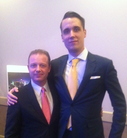
Freedomway.ca
facebook.com/stefanaarnio
https://twitter.com/stefanaarnio
http://ca.linkedin.com/in/stefanaarnio
Remember: Please share this article if you found it helpful
"All I know is that I know nothing"
-Socrates
Why is it that in life, the smarter we become, the less we know?
When I was 7 years old, I was the smartest person in the world. I knew everything there was to know about space, the planets and the solar system.
When I was 7, the facts of the solar system were as follows:
- We have 9 planets
- A sun
- A bunch of stars
If I knew these basic facts, I knew everything there was to know about outer space and received a gold star.
With this limited knowledge, I knew 100% of what there was to know about space and was an expert until junior high when suddenly, the subject of outer space expanded and became more complicated.
I started to learn that I was no longer an expert on outer space because now we had to know:
- That the sun is made of gas
- Gravity holds the solar system together
- The planets have multiple moons that orbit them etc.
Suddenly, I went from being a 7 year old expert to a 12 year old ignoramus who had to re-learn the facts of the universe.
When I was 7 I knew it all, when I was 12 I suddenly became ignorant about the universe.
In high school, I ran into the same problem. New information about the universe flooded my context through physics and chemistry. My knowledge base exploded and I could not keep up with all of the new information. With each new level of proficiency, I learned that in-fact, I knew nothing about the universe.
With each new level of information, I knew less and less. The more I studied, the less I knew.
Today I know virtually nothing about space and the solar system.
Even facts that used to be true are suddenly un-true. For example: We used to have 9 planets and now there are 8.
Pluto is no longer a planet... what changed?
What I used to know is no longer relevant in today's world.
As Einstein says: "change is the only constant in the universe".
How is a person supposed to keep up with all of the new information that is introduced to us every day in this brave new world?
We become experts in a field, learn everything there is to know and suddenly the information changes, the market changes, or we find the "next" level in our field.
No matter what we do, we know nothing.
ENTER ZERO BASED THINKING
Zero based thinking is the concept of always knowing nothing.
In zero based thinking, we are always at the beginning... we forget everything we used to know.
The reason why we must forget our prior knowledge is because what we knew yesterday no longer applies in our current context.
The same concept applies when we want to take our business or our life to the next level and bring it into the future.
"If you do what you have always done, you will receive what you have always got."
Zero based thinking applies when we want to take our life and our business to the next level.
For example, when you are a child and begin to earn money, you are 2 figure earner or a 3 figure earner. You get a paper route, work part time, save up your pennies and make dollars.
When you're in high school, you have a part time job babysitting or flipping burgers and become a 4 figure earner working 2 or 3 months of the year at a summer job. Becoming a 4 figure earner is a different process than becoming a 3 figure earner.
Of course, the chain continues...
To become a 5 figure earner, you enter the world of "full time employment". Through promotions and proficiency in the corporate world, you can transform into a 6 figure earner. However, this is where most people get stuck.
When we become 6 figure earners, our context usually becomes frozen. We think we know everything there is to know and our egos keep us from learning how to get to the next level.
To jump to the next level, we must use Zero Based thinking and forget everything we used to know about earning money because a 7 figure earner follows a completely different process than a 6 figure earner.
Usually a person can reach 6 figures by pure effort and energy. Hard work, blood, sweat and tears can produce 6 figures quite easily these days and many people achieve this accomplishment.
However, to reach 7 figures is completely different. 7 figures is a different set of actions and a wildly different mind set. Hard work alone will not allow a person to jump from 6 to 7 figures.
To become a 7 figure earner, we must "build a business", build a team, build systems, build marketing campaigns, manage people, sell, and essentially run an enterprise.
We must unlearn what we used to know as a 2 figure, 3 figure, 4 figure, 5 figure and 6 figure earner stages because 7 figures is a completely different ball game.
Naturally, the chain continues. 8 figures is completely different from 7 and 9 figures is completely different from 8.
But what is the lesson?
No matter what "level" we are on in life, we must always employ Zero based thinking and approach our situation with fresh eyes. We must deconstruct what we used to know and re-learn the new facts of the world as they become relevant to us in a new context.
Unfortunately, egos and pride stop us from using zero based thinking consistently and often, we need outside personal help from a coach or mentor to expand our context and allow us to see outside of our tiny "box".
For myself in my business, I have completely changed my thinking this year from January 2012 until now December 2012.
I started off with a 5 figure mindset and through coaching and mentoring, I have been able to expand my context. This year alone, I have expanded to a 6 figure mindset and am now approaching a 7 figure mindset.
All that I have to do is execute actions based on my mindset and let the results catch up to my thinking. This process will likely take 12-24 months.
What is wonderful about expanding the mind through Zero based thinking is that: "an expanded mind never returns to it's original size".
What becomes challenging throughout the process, however, is to keep the Zero based mindset and to refrain from becoming a "know it all".
This year I have re-built my website 4 times, re-designed my business cards 6 times, changed my business model 6 times and will likely re-brand before the year is over.
I am constantly "back at the beginning" in my learning process and this is where major growth comes from.
If you are interested in taking your business to the next level, using Zero based thinking can be a simple process.
Find someone who is more successful than you and get them to coach you to the next level.
To become 6 figures, you must learn from a 7 figure.
To become 7 figures, you must learn from an 8 figure.
To become 8 figures, you must learn from a 9 figure etc.
The chain never ends and goes on forever... this is the beauty of life.
The real question is, where on the chain do you want to stop?
Thanks for reading,
Stefan Aarnio
Freedomway.ca
facebook.com/stefanaarnio
https://twitter.com/stefanaarnio
http://ca.linkedin.com/in/stefanaarnio
P.S: Please share this article if you found it helpful









 RSS Feed
RSS Feed

